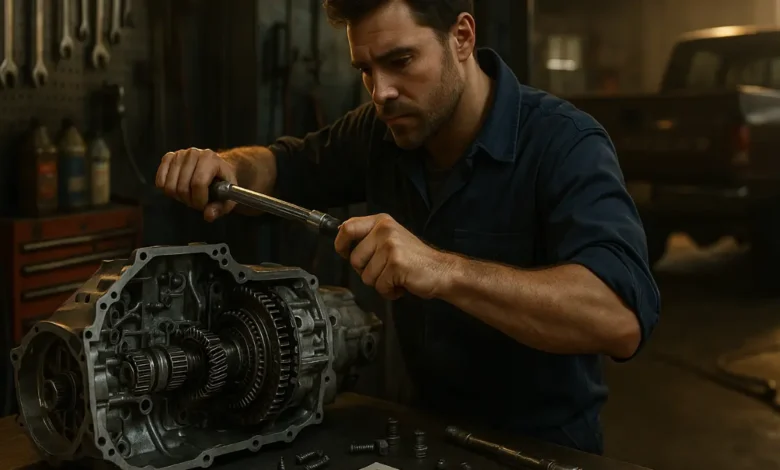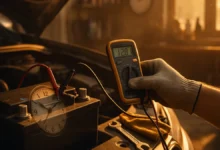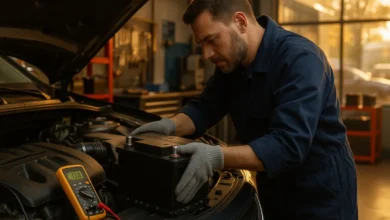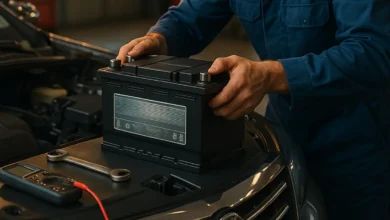Mastering the 4L60E Transmission: Inside GM’s Most Iconic Automatic Gearbox

Discover everything about the 4L60E transmission — its design, operation, common problems, upgrades, and maintenance. A complete expert guide made easy to read and optimized for clarity.
The 4L60E transmission is one of General Motors’ most recognized and widely used automatic gearboxes, known for its blend of strength, reliability, and smooth performance. Whether it’s in a Chevrolet truck, GMC SUV, or performance car, the 4L60E has served as a cornerstone of GM’s automatic transmission lineup for decades.
What sets the 4L60E transmission apart is its evolution from older hydraulically controlled units to a modern, electronically controlled system. This advancement gave vehicles better shifting accuracy, improved fuel efficiency, and reduced wear on internal components. Understanding how it works, where it shines, and how to maintain it properly can help any driver, mechanic, or performance enthusiast get the most from this legendary piece of engineering.
History and Evolution of the 4L60E Transmission
The story of the 4L60E transmission begins with its predecessor — the 700R4. Introduced in the early eighties, the 700R4 marked a turning point for GM’s automatic transmissions. It brought in overdrive gear ratios that improved highway mileage without sacrificing strength. As vehicle electronics advanced, GM took the robust core design of the 700R4 and replaced the hydraulic controls with electronic solenoids and sensors, creating what we now know as the 4L60E transmission.
The name 4L60E breaks down into a simple code. The “4” represents four forward gears, the “L” stands for longitudinal installation (rear-wheel drive layout), “60” refers to its torque capacity rating, and “E” indicates it’s electronically controlled. This naming pattern became standard for GM transmissions that followed.
The first 4L60E transmissions appeared in the early nineties, and over time GM refined them with stronger internals, better valve bodies, and updated torque converters. Later variants like the 4L65E and 4L70E expanded on the same architecture, offering greater torque capacity for high-output engines. These refinements helped extend the 4L60E’s legacy well into modern vehicles before GM gradually shifted to six-speed and eight-speed designs.
Core Design and How the 4L60E Works
At its heart, the 4L60E transmission combines mechanical precision with electronic intelligence. It features a planetary gearset that provides four forward ratios plus reverse, along with a lock-up torque converter for efficient power transfer.
Unlike older automatics that relied on vacuum modulators and throttle cables, the 4L60E uses electronic solenoids managed by the Powertrain Control Module (PCM). This computer monitors throttle position, vehicle speed, engine load, and temperature to determine when and how the transmission should shift.
This integration allows smoother and faster gear changes, improved fuel economy, and adaptive learning — meaning the transmission can adjust its behavior over time based on driving habits. For example, in a city-driven vehicle, the PCM may favor smoother, earlier shifts, while in a towing application it may hold gears longer to maximize torque.
Applications and Vehicle Compatibility
The 4L60E transmission saw use in a vast range of GM vehicles, from family sedans to high-performance sports cars and rugged trucks. It became a staple in Chevrolet Silverado, Tahoe, Suburban, Camaro, Corvette, GMC Sierra, and even some Cadillac and Pontiac models.
This wide compatibility came from GM’s modular design philosophy. By using different bell housings, tailshaft lengths, and torque converter configurations, the same basic 4L60E architecture could serve dozens of platforms. Whether behind a V6 or a small-block V8, the transmission offered dependable performance for both daily drivers and fleet workhorses.
Because of this widespread use, finding parts, upgrades, and rebuild kits for the 4L60E transmission is easier than for most other transmissions. Its accessibility also makes it a popular choice among custom car builders, especially for LS engine swaps and street-rod conversions.
Technical Specifications and Gear Ratios
The 4L60E transmission uses four forward gears with one overdrive gear for highway cruising. The ratios are carefully chosen to balance acceleration and fuel economy:
| Gear | Ratio | Purpose |
|---|---|---|
| First | 3.06:1 | Strong launch and low-speed power |
| Second | 1.63:1 | Smooth transition between acceleration ranges |
| Third | 1.00:1 | Direct drive for balanced power output |
| Fourth (Overdrive) | 0.70:1 | Lower engine RPM at high speeds |
| Reverse | 2.29:1 | Backward movement with control |
These ratios give the 4L60E a strong low-end feel, making it excellent for heavy vehicles or towing while still allowing relaxed cruising at highway speeds.
Strengths and Weaknesses of the 4L60E Transmission
Like any mechanical system, the 4L60E transmission comes with its own list of advantages and limitations. Its strengths include smooth shifting, widespread parts availability, easy electronic tuning, and good compatibility with both V6 and V8 engines. It’s also light for its torque capacity, which helps with fuel efficiency.
However, the 4L60E can be vulnerable when pushed beyond its design limits. Common issues include worn clutches, faulty shift solenoids, and weak sun shells that can crack under heavy load. Overheating is another major enemy; excessive heat from towing or poor cooling often leads to early failure. That’s why maintaining proper fluid levels and ensuring good cooling through an auxiliary cooler is essential.
Still, for normal driving and moderate performance use, a properly built 4L60E transmission can last well beyond 200,000 miles with regular maintenance.
Common Problems and Diagnosis
When something goes wrong with a 4L60E transmission, symptoms often appear gradually. Slipping between gears, delayed engagement, harsh shifts, or no movement in certain gears are telltale signs.
Electronic control means problems can stem from either mechanical wear or sensor and solenoid issues. For instance, a failed shift solenoid may cause the transmission to skip a gear or enter “limp mode.” Faulty wiring or a bad throttle position sensor can also confuse the PCM and affect shifting behavior.
Mechanically, worn clutch packs, a damaged pump, or a cracked reaction shell (known as the “beast” shell) are frequent culprits. These problems usually appear after high mileage or poor maintenance. Regular fluid inspections, keeping an eye on color and smell, can prevent these surprises. Burnt or darkened fluid is a clear signal that internal heat is taking a toll.
Maintenance and Longevity Tips
Proper care is what separates a short-lived 4L60E from one that serves faithfully for decades. Fluid changes should occur at consistent intervals, using high-quality Dexron VI transmission fluid. Overfilling or using incorrect fluid types can cause foaming, pressure loss, and shifting issues.
It’s also wise to add an external transmission cooler, especially for vehicles that tow or see frequent stop-and-go driving. Keeping the fluid temperature below 200°F dramatically extends clutch and seal life.
Periodic inspections of the transmission mount, driveshaft yoke, and crossmember bolts ensure smooth operation. Electronic components, like the shift solenoids and wiring harness, should also be checked for corrosion or damage. A simple maintenance plan and awareness of operating conditions go a long way toward maximizing lifespan.
Comparison Between 4L60E, 4L65E, and 700R4
| Transmission | Control Type | Torque Capacity | Strength Notes | Typical Use |
|---|---|---|---|---|
| 700R4 | Hydraulic | Moderate | Early design, non-electronic, simpler internals | Older GM cars and trucks |
| 4L60E | Electronic | Medium-High | Improved solenoids and clutch packs | Trucks, SUVs, and daily drivers |
| 4L65E | Electronic | Higher | Stronger planetaries and input shafts | Performance or heavy-duty use |
This comparison highlights that while the 4L60E transmission remains versatile, the 4L65E offers extra reinforcement for high-torque applications. Still, the 4L60E can be upgraded internally to match or exceed its stronger siblings.
Performance Upgrades and Modifications
For enthusiasts who demand more than stock capability, the 4L60E transmission can be upgraded significantly. Builders often install heavy-duty clutches, improved servos, billet sun shells, and reinforced bands to withstand higher torque.
A popular modification is the Corvette servo upgrade, which increases the apply area and results in firmer, faster 1-2 shifts. Shift kits also modify hydraulic circuits for crisper transitions. For high-power builds, aftermarket torque converters and stronger input shafts become essential.
Electronic tuning plays a huge role as well. Adjusting shift points, line pressure, and torque converter lock-up through tuning software helps optimize the transmission for performance or towing.
How to Identify the Right 4L60E Transmission for Your Vehicle
Because the 4L60E came in so many variations, choosing the right one requires attention to detail. Bell housing bolt patterns, torque converter size, tailshaft length, and connector pin count vary across model years.
For example, earlier versions had 13-pin connectors, while later versions switched to 15 or 17 pins. LS-based engines use a 300mm torque converter, while older small-block engines use a shorter 298mm version. Even the input shaft and valve body can differ slightly, meaning you must match the transmission to your engine and PCM type for compatibility.
When buying used or remanufactured units, always cross-check the model year, connector type, and converter specifications to ensure seamless installation.
The Role of Electronics and Computer Control
The “E” in 4L60E truly defines its character. Unlike earlier transmissions, it relies on a network of sensors and solenoids governed by a computer. This integration allows real-time adjustments based on throttle input, vehicle speed, and driving conditions.
The transmission’s valve body houses solenoids responsible for gear changes. The PCM activates them in specific combinations to produce the correct gear ratio. Pressure control solenoids fine-tune hydraulic pressure to ensure smooth operation without excessive harshness.
For diagnosis, a scan tool can read transmission codes and live data, making it easier to pinpoint faults like a failed solenoid or pressure sensor. This electronic control offers precision but requires careful attention to wiring integrity and sensor calibration.
Rebuilding and Restoring the 4L60E Transmission
When the time comes to rebuild, the 4L60E transmission offers abundant aftermarket support. Complete rebuild kits include clutches, seals, bushings, and steel plates. For more advanced builds, heavy-duty components such as billet servos, hardened sunshells, and upgraded pumps are available.
Rebuilding this transmission requires patience, precision, and clean workspace conditions. Each clutch pack must be measured for clearance, and valve body passages cleaned thoroughly. Even a small piece of debris can cause hydraulic issues later.
Many enthusiasts choose to rebuild their 4L60E as a learning project, but professional rebuilders can provide blueprinted units that outperform factory versions. The cost varies based on parts and labor but generally ranges from moderate to premium depending on desired performance level.
Future of the 4L60E in Modern Automotive Use
Although GM has moved on to six-speed and eight-speed transmissions, the 4L60E continues to live strong in the aftermarket. Classic truck restorations, LS swaps, and off-road projects rely heavily on it because of its availability and adaptability.
Its proven reliability and ease of tuning make it a preferred option for enthusiasts who want modern shifting with traditional simplicity. With proper upgrades, the 4L60E remains capable of handling modern engine power outputs while preserving the familiar mechanical feel of older vehicles.
Frequently Asked Questions about the 4L60E Transmission
What vehicles use the 4L60E transmission?
The 4L60E is found in many Chevrolet, GMC, and Cadillac vehicles such as Silverado, Tahoe, Suburban, Camaro, and Sierra models.
How much power can the 4L60E handle?
A stock unit comfortably handles around 350-400 horsepower, while a built version with upgrades can exceed 600 horsepower when properly tuned.
What fluid should I use for the 4L60E transmission?
Always use Dexron VI automatic transmission fluid for best results. Avoid mixing different types of ATF, as it may cause friction inconsistencies.
How often should I service the 4L60E transmission?
Change the fluid and filter every 30,000–40,000 miles for regular driving, or sooner if towing or under heavy loads.
Can I swap a 4L60E into an older vehicle?
Yes. With the right wiring harness and PCM, the 4L60E can be retrofitted into many older GM vehicles and hot rods.
Why does my 4L60E slip or delay when shifting?
Common causes include worn clutch packs, low fluid level, or faulty solenoids. Scanning for diagnostic codes can identify electrical faults quickly.
How can I make my 4L60E last longer?
Keep the transmission cool, use correct fluid, and avoid aggressive shifting under load. Installing an external cooler greatly improves longevity.
Conclusion
The 4L60E transmission stands as one of the most iconic and dependable automatic transmissions in GM history. It bridges the gap between old-school mechanical toughness and modern electronic control, offering a blend of performance, efficiency, and adaptability that few transmissions can match.
With proper care, timely maintenance, and the right upgrades, the 4L60E can serve reliably for years — whether in a daily-driven pickup, a performance muscle car, or a custom build. Its widespread use ensures that parts, support, and expertise will remain available for generations of drivers and enthusiasts alike.





